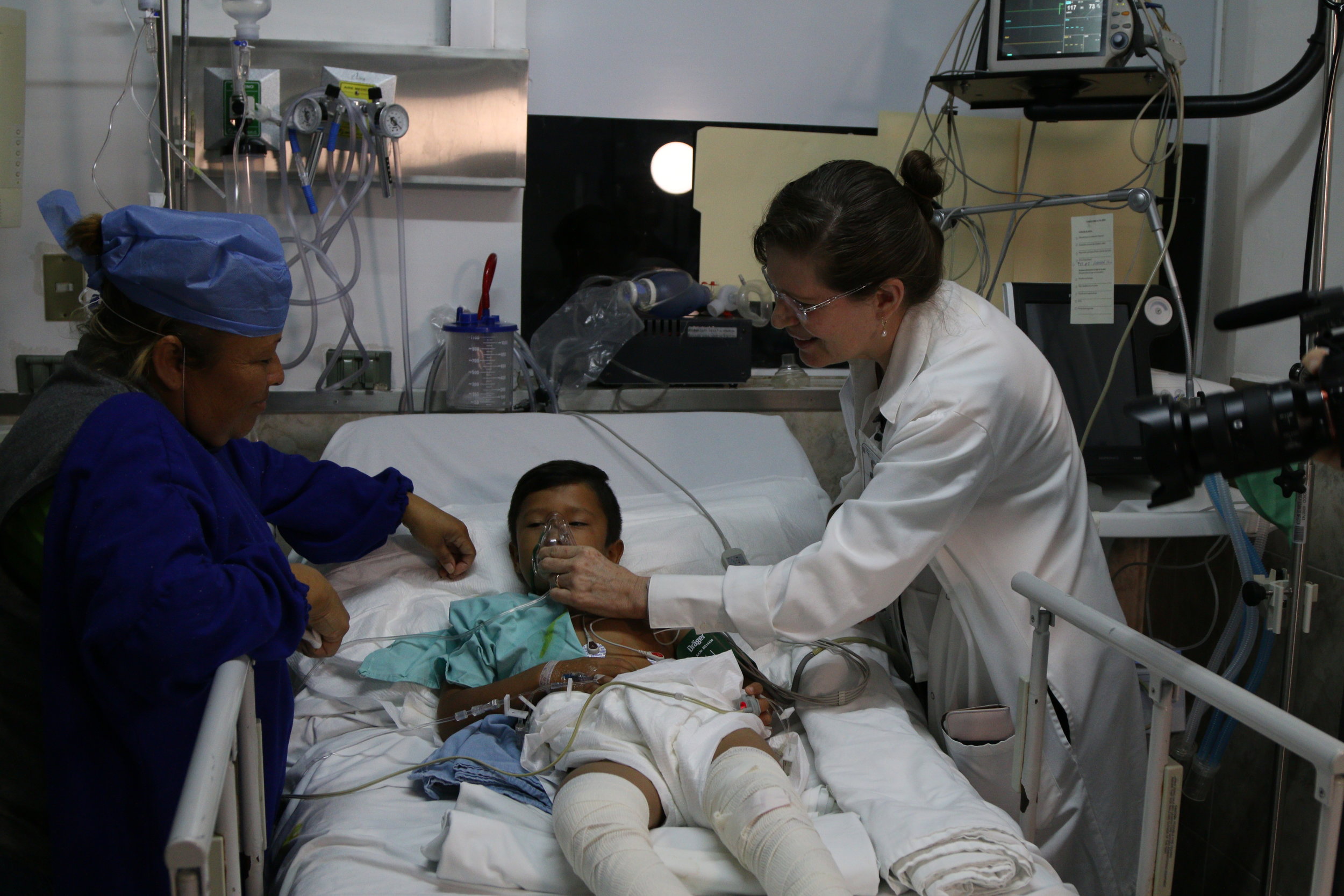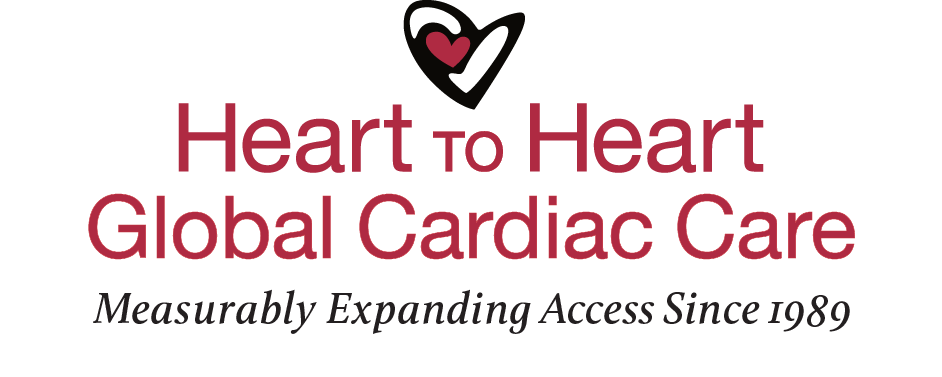In December 2018, Heart to Heart volunteers and staff traveled to conduct our first surgical-educational training mission to Torreon, Mexico. The Heart to Heart-Torreon team examined 20 children with congenital heart disease (CHD) and performed surgery on five. The trip highlight was performing the hospital’s first ever open heart surgery on a child.

ECHOCARDIOGRAM
Timely diagnosis of a heart defect can mean the difference between life and death for a child. An echocardiography machine (shown here) provides ultrasound images of the heart while it is beating (an echocardiogram). The moving images enable clinicians to gain detailed information regarding the size and function of heart chambers, valves, and major blood vessels attached to the heart. Echo machines are the most commonly used equipment for diagnosing heart problems.

WINDOW OF OPPORTUNITY
In regions of the world where heart surgery programs are not yet developed, there is a considerable lack of awareness of CHD. Hence children with CHD go undiagnosed until they are sick enough to show symptoms, or even, worse, die a sudden death. Unfortunately, a late diagnosis means heart surgery can no longer save some children. Heart to Heart volunteers (shown here) Kavitha Pundi, MD (left) and echosonographer Dina Schmidt (seated) examined and diagnosed 20 children. Sadly, many had already become inoperable.

HEART TO HEART’S FIRST PATIENT IN MEXICO
A bright, energetic first grader, seven-year-old Alejandro enjoys playing soccer and anything and everything related to Spider-Man. Flanked by his mother on one side and Heart to Heart volunteer Grace Arteaga, MD of the Mayo Clinic on the other, Alejandro is well cared for in the ICU.

MENTORING TO BUILD CAPACITY
Working closely with the nascent local Torreon team, our volunteers prepared to perform the FIRST EVER open heart surgery on a child at Torreon’s well-established hospital. Heart to Heart volunteer, pediatric cardiac anesthesiologist Laura Berenstain, MD, (right) discusses processes critical for maintaining patient safety before, during, and immediately after open heart surgery.

LACK OF TRAINED SPECIALISTS
Aitana was born with one of the most common heart defects. But where her family lives, most children born with CHD go undetected and untreated, leading to premature and/or sudden death. The Heart to Heart-Torreon Team performed life-saving surgery on Aitana on December 11, 2018. Aitana was the first child ever to undergo open heart surgery at the University Hospital, Torreon, Mexico.

OPPORTUNITY TO MAKE A DIFFERENCE
Heart to Heart volunteers had the opportunity to work with Torreon’s emerging team to jointly perform their first open heart surgery on a child at their hospital. Moments before open heart surgery, Heart to Heart volunteer physicians, Laura Berenstain, MD (left) and Kavitha Pundi, MD (right) monitor Baby Aitana as they administer anesthesia.

TEAM WORK
To begin a pediatric heart program requires a minimum of 25 specialists, including surgeons, anesthesiologists, perfusionists, cardiologists, and intensive care doctors and nurses. After leaving the operating room, the transport team (shown here) delivers our young patient to the ICU, where a team of doctors and nurses specializing in the post-operative care of children after heart surgery will provide her with bedside care 24/7.

ROLE OF NURSES
There are several different types of nurses needed to field a full pediatric cardiac team, including operating room (OR) nurses (aka surgical technicians), OR circulating nurses, as well as a cadre of pediatric cardiac intensive care nurses, who work around the clock 365 days a year. Heart to Heart volunteer Olesya Dushkova (left) works with the OR nursing staff in Torreon, Mexico to review best practices in sterile technique.

AN ART AND SCIENCE
Pediatric cardiac medicine is both an art and a science. Our success mantra: the right patient, at the right time, with the right operation. Surgical step one for our 6-month old patient is making an incision in her chest (shown here).

LOCAL HOLIDAY
Heart to Heart's team arrived during a week-long celebration of the Virgin of Guadalupe. Each day during our training mission, locals participated in parades marked by festive music and dance (shown here). Parades marched through town culminating at the Church of Our Lady of Guadalupe.

COMMUNITY SUPPORT
It takes a village to support the development of a new children’s heart program. Heart to Heart builds relationships with regional stakeholders who will not only support our multiyear educational collaboration, but will financially support the evolving local pediatric team during and after our collaboration. A panel of supportive administrators and officials (shown here) discuss the Heart to Heart-Torreon collaboration at a press conference televised nationally.

SHARING YEARS OF MEDICAL EXPERIENCE
Heart to Heart’s volunteers are leading physicians as well as committed educators: they generously share their decades of experience so that aspiring pediatric cardiac specialists in areas of need around the world can begin programs to save children with CHD in their local communities. Pediatric cardiac surgeon Gary W. Raff, MD (UC Davis Medical Center) and pediatric cardiac intensive care physician Grace Arteaga, MD (Mayo Clinic, Rochester) helped lead our first training mission in Mexico.

SAVING THE LIFE OF A CHILD
To date, nearly 30,000 children's lives have been saved through cardiac surgical procedures performed at Heart to Heart partner sites around the globe. Sweet Aitana (shown here) two days post surgery, recovering and resting well in the pediatric intensive care unit.

READY TO GO HOME
All of us on the Heart to Heart-Torreon team fell in love with Alejandro’s beautiful smile and spirit. Days after surgery, Alejandro gazes through the window of the ICU, anticipating going home and back to school to play with his friends.

HOSPITAL UNIVERSITARIO
Located in the northern part of the country, the city of Torreon is home to Latin America’s largest university–the Universidad Nacional Autónoma de México. Hospital Universitario (shown here) serves as a medical hub for the approximately 10 million people living in this tri-state area of northern Mexico.

